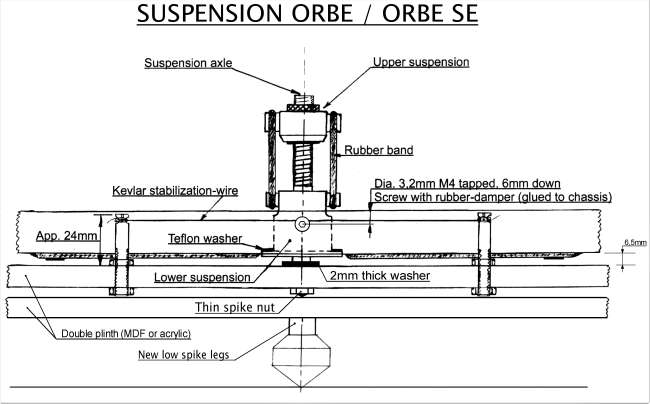
[ Home | Staff & Contacts | HiFi Playground | Listening tests | DIY & Tweakings | Music & Books]

Product: Turntable Modification service for Michell turntables
Manufacturer: Gert Pedersen, Denmark
Price: Depends on what you want doing to what turntable;
See Pedersen price menu but as usual
YMMV
Author: Mark Wheeler - TNT UK
Written: Spring 2020
In part 1-2-3 we learned that the inspiration for the Pedersen modifications began with Niels Nørby of Copenhagen. Considerable experimentation and investigation had revealed the principle cause of the plummy emphasis of the Michell Gyrodec and Michell Orbe to be due to be steel spring and subchassis resonance. The solution to the lower midrange resonance was primarily located in subchassis support and internal dynamics. Such colouration can trick the listener's ear into believing that the bass is artificially deep. This illusion is also created by some other subchassis turntables, including the Linn Sondek in its glory years, with a resonant band nearly an octave below that of the Gyrodec. The subchassis internal misbehaviour is corrected by the Pedersen sand and (chemical metal) glue. The extra rigidity of the modified Orbe tames and extends the low frequency response. The low frequency bandwidth is genuinely extended further than the standard issue Orbe, which is already famed as one of the best turntables in this respect.
Stripped of this contribution to lower midrange overhang, the Gyro/Orbe family reveals further potential for tightening up its capacity to retrieve more groove information while adding less of its own. Niels realised that the suspended steel springs ring like the reverb unit in the bottom of a Fender Twin. Coincidentally this steel spring bloom is primarily embedded in the same mechanical subsystem which is behind another familiar challenge to subchassis turntables. Supporting the mass of the subchassis-platter system allows the subchassis to swing about the axis of the platter itself like a pendulum, from which set-up bounce paranoia arises. This was the same concern about precession that inspired the Rivelin Eclipse turntable (back in the late 80s Sondek dominance heyday) and the Audio Files Spoke Sondek modification). This horizontal movement of the platter, despite being at a microscopic level, changes the position of the platter in relation to the motor and thus introduces speed irregularities. The elasticity of the belt combines with this to create an unstable system guaranteed to introduce pitch instability in the form of dynamic wow. Dynamic wow is that which is caused by changes in stylus drag due to changes in modulation level. Heavier tracking forces and larger stylus contact patches have more of this friction. The suspension-subchassis-platter system responds by the rotation changing and/or the subchassis moving. Other experimenters were already playing with partially inflated bicycle inner tubes beneath the Gyrodec subchassis, and assorted alternatives to the springs themselves. There is a thriving market for aftermarket Gyro/Orbe chassis danglers (not necessarily suspensions) on fleabay.
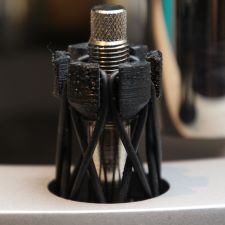
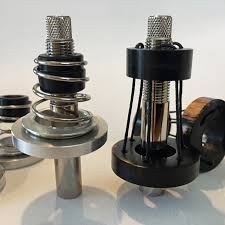
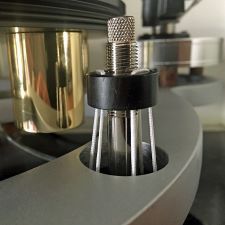
Niels Nørby created a succession of string suspension arrangement by trial and error. The chosen iteration, engineered by Gert Pedersen, improved the rhythm, the soundstage and the bass. As the video shows, the rubber bands (O rings) alone, make the precession situation worse, allowing horizontal oscillation with little vertical compliance. This, in combination with belt compliance would guarantee pitch instability and dynamic wow in epic proportions. Hence the kevlar tie wires are the key to this aspect of the Pedersen Gyrodec/Orbe. Given the proliferation of O-ring variations on offer for the Gyro/Orbe family, this aspect is an essential differentiation from other O-ring approaches which may employ twisted or triangulated O-rings to achieve that essential horizontal stability.
Orbe Swing from Mark on Vimeo.
“Why not just attach kevlar tie wires to an otherwise standard Orbe/Gyrodec?” Enquire Plebs, stage left, perfectly reasonably
The existing Michell springs are designed to permit vertical compliance. Vertical compliance is the primary function of subchassis turntables. If vertical compliance were possible post-Pedersen, the kevlar would have to be able to stretch (it doesn't) and the increased forces on it would result in either the end pillars gradually loosening or the central grommet being cut through by the kevlar thread. Niels Nørby and Gert Pedersen therefore created an isolation system that both avoids springs and their associated boinginess and avoids instability.
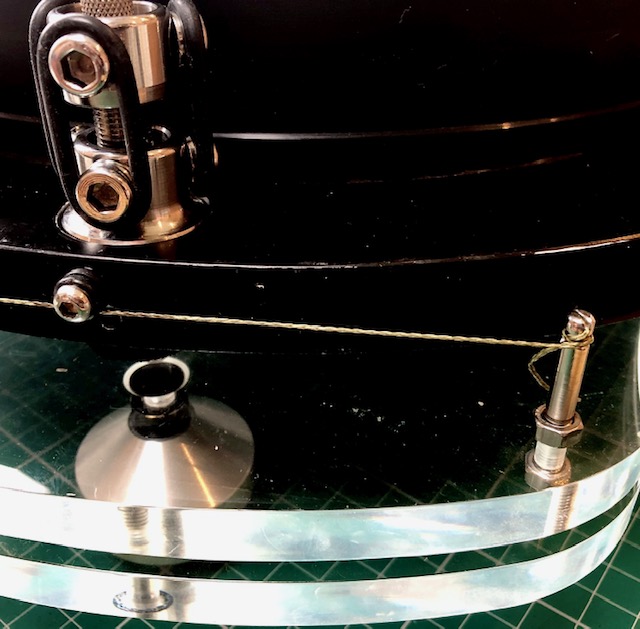
Things are rarely perfect, nor even simple. The whole point of the Orbe 2 layer chassis base, separated by spikes in sockets (as distinct from the single layer Gyrodec) is extra isolation from motor vibration and other structure borne vibration. As described in part one – the listening test motor noise is less isolated by the Pedersen chassis arrangement than the standard Orbe SE, which in turn, is even better in this respect than the full fat Orbe. There is a simple 100% effective solution. Cut a motor pod sized circle of material like Deflex (they can supply flat sheets of their elastomeric polymer as well as their well known Foculpods, Powerpads and Deflex loudspeaker treatment). Similar Cured Polyurethane Polymer is likely to be equally as effective. The circle must match the motor base diameter. Slip this disc of Deflex (or similar) beneath the motor pod. Motor noise problem is solved and the belt now runs at the same height that it did before the Pedersen modifications.
Another assembly care essential is somehow marking the O-ring cleats so that they do not become mixed up. Each is thread tapped into its own unique position. This means that the radius ground onto the inner end of the cleat matches its position within the suspension tower. Get any mixed up mixed up and the possibilities for error increase geometrically.
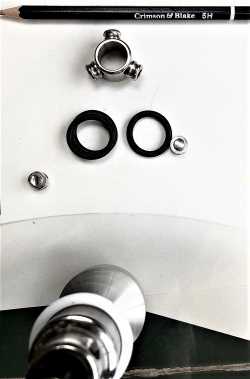
Gert Pedersen explains that tension is essential to the function of the "suspension" kevlar cords. He describes how they need regular checks for tightness and alignment to function correctly.
“The stabilizer-wires made of Kevlar are very strong and should be kept tight and straight by adjustment” advises Gert. However he fails to explain exactly how tight, merely suggesting “Like a guitar string&rdquo. Assuming a standard issue 6 string guitar, this could mean E2=82.41Hz, A2=110Hz, D3=146.8Hz, G3=196Hz, B3=246.9Hz, E4=329.6Hz (assuming concert pitch rather than some esoteric or historic variation) and hours of fun with pitch pipes or electronic tuners. However, even tuning towards the lowest of these does set up a sympathetic vibration in the soundfield.
Tuning the kevlar ties “like a guitar” creates its own euphonic emphasis and overhang. This effect characterised the first auditions of the Pedersen Orbe SE until a set up procedure was found by trial and error. The self resonance of the kevlar ties is easily identified by a signal generator through the system at high volume creating a monotonic sound field around Pedersen Orbe SE. Runaway feedback is easily possible with the wrong kevlar tension. The simple solution is tuning the kevlar wires so that they are only just tight, and ensuring each one rings at a slightly different frequency
Gert also suggests: “When using the Record-Clamp upon mounting a record, the chassis-suspension can reach the plinth without problems. Check the height, 6,5mm now and then.” Your Old Scribe has experienced no problems of this sort over several months of use, despite often adding nor removing the clamp while the platter turns.
“The extension in both bass and treble are improved a lot. The rest of the tone-area is naturally improved as well, because the chassis is now completely fastened horizontally, but also rubber suspended. This provides much quieter sound-rendering,” explains Gert Pedersen. This explanation does depend on the turntable being supported by an inert platform not subject to vibration.
The kevlar ties were probably developed on full plinth Gyrodecs and Orbes. This is inferred by the choice to connect them centrally adjacent to the suspension towers with two pillars per kevlar tie (six across the whole Gyrodec or Orbe chassis). Transferred to the Spider Edition of the Gyro needs a whole new chassis creating from acrylic (150€) to accommodate the extra width and larger diameter to achieve this. The whole problem is doubled on the Orbe SE because it requires two layers of acrylic (300€) to achieve a similar result.
Form a cost effective engineering standpoint this does seem wasteful. The Orbe SE could retain its original lower acrylic tricorn and utilise a variation of the Pedersen acrylic base created for the Gyro. Aesthetically, the Orbe subchassis and platter not longer seem to float above their shelf and now look more similar to other typical plinth-less turntables sprawling over their base section.Greater surface area offers more opportunity for airborne vibration to strike the surface and more mass to store more vibrational energy from whatever source (shelf structure, motor or airborne). Acrylic is an oil product. Another approach might have been the central kevlar attachment point coming from the original chassis base and the two end points attached to the subchassis itself in a section of the subchassis with more cast thickness for the screws to tap into.
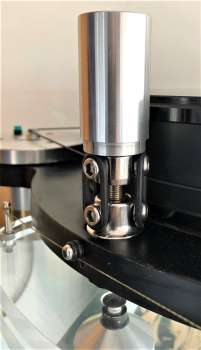
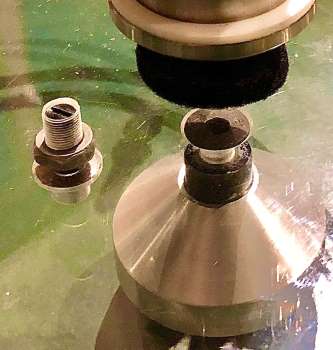
The Peterson does take at least as much fettling and fine tuning as any sprung subchassis turntable, even though it is sprung by a fundamentally different mechanism from the dangly bouncing Michell and Logic turntables of this world. This digresses even further from the compression sprung AR's, Thorens, Aristons and Linns. If it took Scottish engineering ingenuity over 2 decades to understand what's going on between some wood/mdf, 3 conical springs and some suspended metals, sufficient to make one that seldom needs readjustment, imagine the challenge presented by 9 O-rings and 6 lengths of Kevlar cord, all in tension.
“So what does it take to make it work,” interupt Plebs Chorus, stage left
Oh... and the latter 6 Kevlar cords are working in 6 different vectors on a plane at 90° to the 9 O-rings.
Siting the Pedersonified Michell Orbe on the Origin Live Ultra wall shelf
creates new interactions.
The frame of this this wall shelf is adjustable with a tunable horizontal mode.
Under the Linn Sondek for which the Origin Live Ultra wall support was designed,
variations in the tension of the rear outriggers affects bass quantity and quality as well as
a collapse of the soundstage.
With the
Having tried the Pedersen Orbe on various planks & platforms, being, like the recently reviewed Audio Files Spoke Linn, even more sensitive than a standard issue subchassis turntable (let alone a solid plinth design), your Old Scribe established an order of preference. Extraordinarily, the top three are the same order as the Audio Files Spoke Sondek.
As noted in the first quick listen, the extra complexity and user adjustments demanded by the Origin Live Ultra wall shelf,
are worth the effort, and you wouldn't have read this far if you were bothered by such things.
The 10mm laminated glass shelf offers most transparency...
“GROAN,” moan Plebs Chorus, anticipating nthat pun like an oncoming train in a tunnel
The various types of wood, or engineered wood, planks all impart more obvious colouration than they had exhibited with the conventional Orbe suspension.
Second place in the racks/supports stakes, like the Linn family, and leading the field among the floor stands, goes to the Something Solid XR range of cable suspended shelf racks. In The Area by ILS & Solo on the Blame project of Good Looking Records on side 1 of the classic post-jungle Logical Progression series (Level 2) typifies the differences. There are a series of well sampled bass cadences which on most wide bandwidth systems sound as they would in a large club with a well sorted sound system.
Here, aspects of this track are more explicit with the Pedersen Orbe atop the Something Solid XR4 rack with its native end-grain balsa shelves. Third place is a close showing making progress in the final furlong, the sand filled Wilko stores generic entertainment centre rack with the 10mm laminated glass shelf seated on Polycrystal Isolators. This least expensive option actually reproduced more forceful bass than either of the more engineered shelf supports, at the expense of soundstage and clarity.
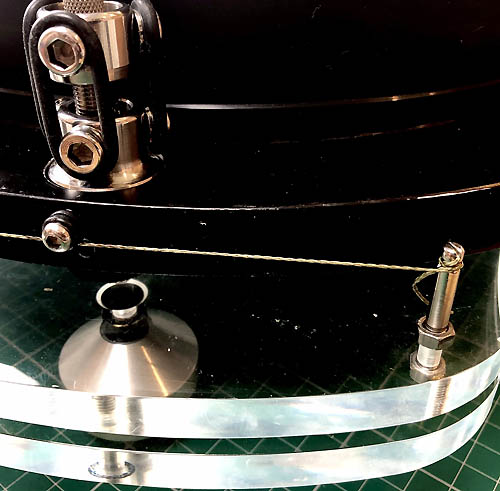
The primary fundamental Pedersen change from the original Michell Orbe of explicit suspension. The Pedersen Orbe is more of an isolated subchassis turntable, although it is still Literally a suspended subchassis, dangling from the towers. The subchassis is now also constrained by 3 kevlar ties acting in 6 directions on one plane. This unique approach does partially short-circuit the subchassis vibration isolation, but this can be mitigated.
The advantages of the Pedersen suspension are much better articulation of low frequencies and much reduced dynamic wow. The basic architecture of the Michell Orbe remains the same. There is still the familiar cavernous soundstage, expansive and expressive qualities, but now without the Orbe's two primary sins of commission. The inevitable subchassis turntable precession is now absent, as is the bugbear of lower midrange emphasis muddying the otherwise pellucid audio picture.
The combination of modified subchassis isolation, together with improved subchassis resonant behaviour, raises the Michell Orbe performance to the next league. Most noticeable is the greater midrange transparency. Pitch stability and slam are also improved.
For those who love their Michell Orbe, but would like to drag a little more information from those tiny LP grooves, the Pedersen modifications are well worth the effort. In the light of the experience of this build, a full plinth Orbe would be the best place to start. A Pedersonified Michell Gyrodec is unlikely to offer as much bang for your buck, and given a choice between a plain bone stock Michell Orbe vs a Pedersen Gyrodec, this author would prefer the (admittedly more expensive) Orbe and save the Pedersen modifications until they too can be afforded. The reduced subchassis isolation of the Pedersen suspension can be mitigated by the Michell Orbe two layer base chassis and the addition of some flexible polymer sheet below the motor pod.
Unlike the original Michell Gyrodec and Michell Orbe models, the Pedersen Orbe and Pedersen Gyrodec are no longer floating subchassis turntables. The Pedersen versions might be better described as Isolation Subchassis turntables, or Decoupled Subchassis turntables. Hence, the reduced subchassis resonances are crucial to the Pedersen concept, the whole being grater than the sum of the parts. Extended listening is gradually revealing the true extent of the altered sound, and the arm board isolation system will be considered in the final episode of Vinyl Frontiers: Pedersen Michell Modifications.
|
Music enjoyed while writing this review |
Reference system |
|---|---|
|
on vinyl of course
|
Equipment used in this review:
Extensive and ever evolving acoustic treatment including corner bass absorption, high frequency (above 2kHz) absorption at primary tweeter reflection points, high frequency diffusers at other critical points, sloping ceiling with absorber >2kHz. Solid walls and argon filled triple glazing and no radiators. Hanging rugs and thick textured floor rug between listeners and loudspeakers, solid slate floor. Some wire is used to join these components together. No interconnects cost more than 10% of the device at each end, much of it made by the Old Scribe from high quality components without Pixie Dust. Old Scribe amplifier-to-loudspeaker wire (full range, mid-range, tweeter) is ultra-low impedance Black Rhodium S900, a low-Z variation (3x3mm^2 csa) on the Black Rhodium S300 & S600 cable that came out well in Ben Duncan's objective and subjective correlation tests, selected primarily to match the OPT/driver damping factor, not for any magical qualities. Bass only loudspeaker cable Naim NACA 5, which remains rarely challenged below 300Hz. Mains is supplied by an audio only ring main with Radex earth (ground) non-inductive connections and a technical earth. Crossover and power amplifiers fed by a minimum connections hydra. Sources and pre-amp from terminal blocks within the audio only ring. |
Copyright ©2020 Mark Wheeler - mark@tnt-audio.com - www.tnt-audio.com
[ Home | Staff & Contacts | HiFi Playground | Listening tests | DIY & Tweakings | Music & Books ]